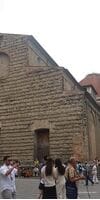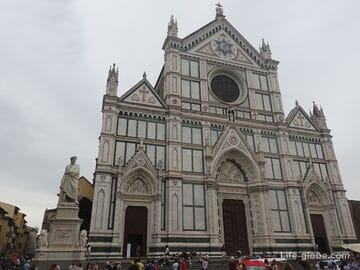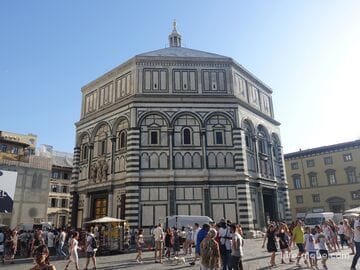The Basilica of San Lorenzo, translated from Italian: the Church of St. Lawrence (Basilica di San Lorenzo) is the oldest Florentine cathedral and one of the largest churches in the city, which was the city cathedral and the parish church of the Medici family.
San Lorenzo is a monumental complex, which is one of the most popular attractions in Florence.
The St. Lawrence complex can be divided into three squares: the basilica with the old sacristy, monasteries, museum and crypt; the Medici Library, created by Michelangelo; the new sacristy and the Medici Chapel, created by Michelangelo as the tomb of an influential family.
The complex is located in the central part of Florence, on the eponymous square of San Lorenzo (Piazza San Lorenzo).

Panoramic view of the complex of San Lorenzo and the adjacent ensemble from the observation deck the domes of the Cathedral of Florence
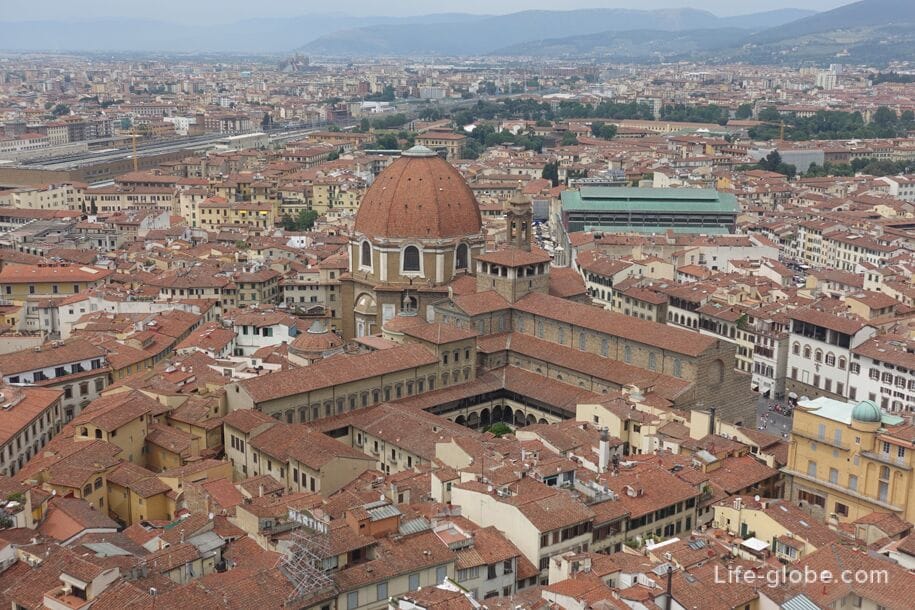
The first basilica was founded in the 4th century and consecrated in 393 as a city cathedral in honor of the martyr Lorenzo in the presence of St. Ambrose. Then the basilica was located outside the city walls. This cathedral has not survived to this day.
In 1418, Giovanni di Bicci de' Medici offered to finance a new church. The project belonged to the architect Filippo Brunelleschi. The modified building was completed only after the death of Brunelleschi - Antonio Manetti in 1461; however, the chapels were built until the 1490s.
Subsequently, the complex was restored. Despite this, the complex retains the structure and features given to it by Brunelleschi.
On behalf of Pope Leo X, the son of Lorenzo the Magnificent, the basilica had to be adequately completed with a beautiful marble facade. In 1518, the pope entrusted this to Michelangelo, but the task was never realized and the basilica still remains in a strict form. Michelangelo's drawings and wooden model, exhibited today at the Museo di Casa Buonarroti in Florence, can give an idea of the scale of Michelangelo's project.
Throughout history, the Basilica of San Lorenzo was the parish church of the Medici family and was a cathedral for 300 years, until the official residence of the bishop was moved to the church of Santa Reparata, of which today there are ruins that can be visited. Weddings, baptisms and funerals were held in San Lorenzo, the Medici attended large state ceremonies here, and here they buried all their dead to the last descendant, Anna Maria Luisa.
The Church of St. Lawrence has the title of a minor basilica. It stands out with large and smaller domes, as well as an architectural bell tower.
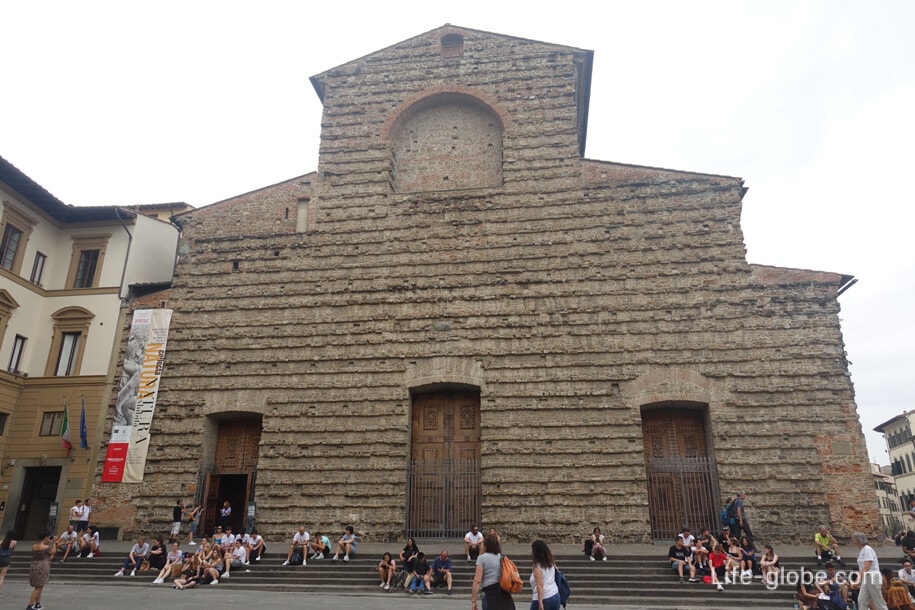
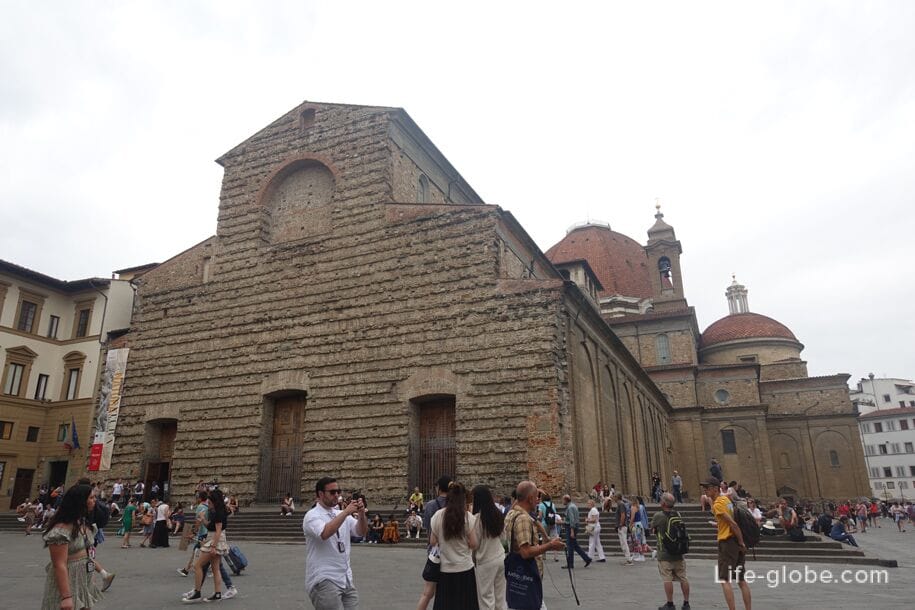
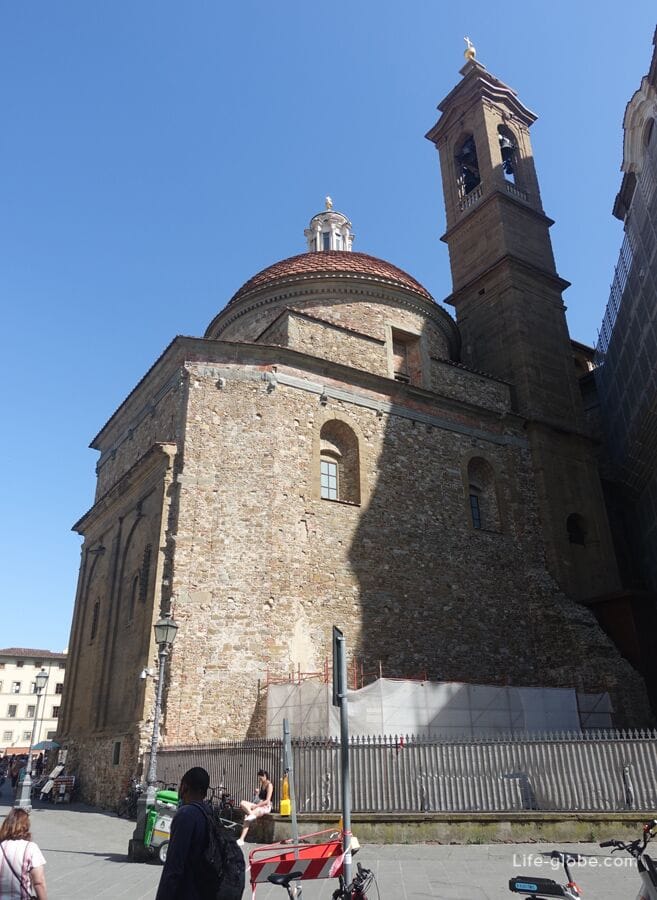
The complex of the Basilica of San Lorenzo
The Basilica
The interior of the Basilica of San Lorenzo demonstrates many innovative features of the developing style of Renaissance architecture.
The basilica has three naves, which are separated by columns of the Corinthian Order with semicircular arches, as well as the main altar, side altars and a balcony.
The interior of the temple forms a plan in the form of a Latin cross and a spacious middle cross formed by the intersection of the nave and transept, covered by a dome. The side walls are decorated with pilasters framing the semicircular arches of the chapels.
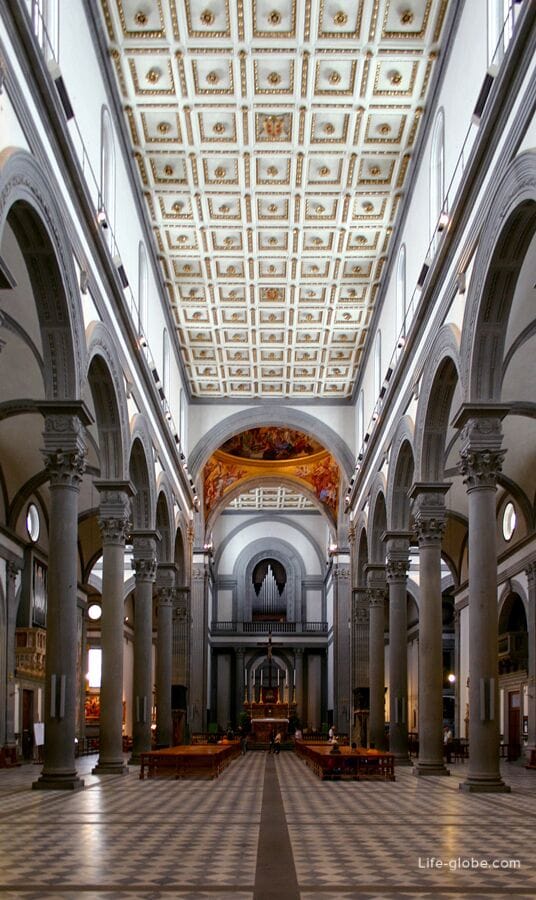

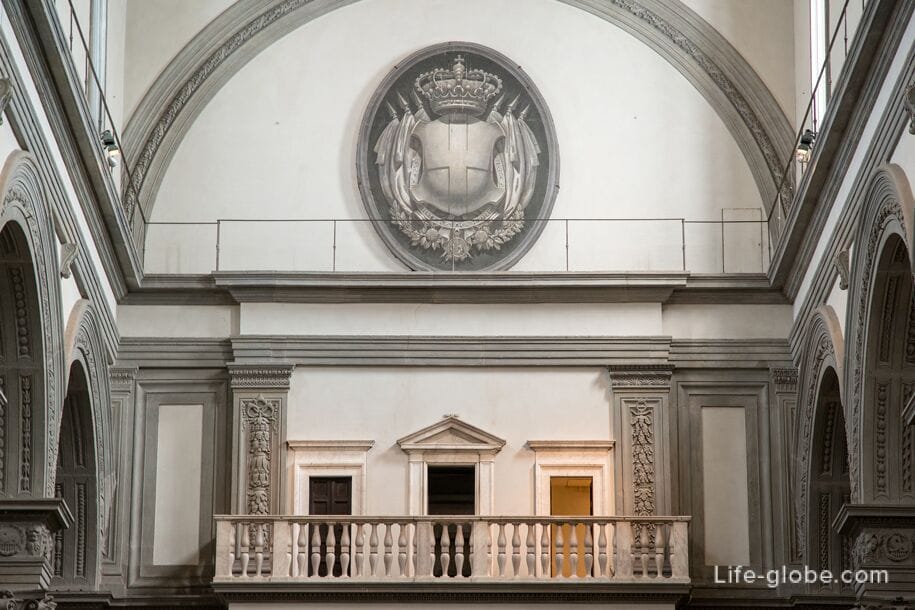
The interior of the dome is covered with frescoes on the theme "Glory of the Florentine Saints".
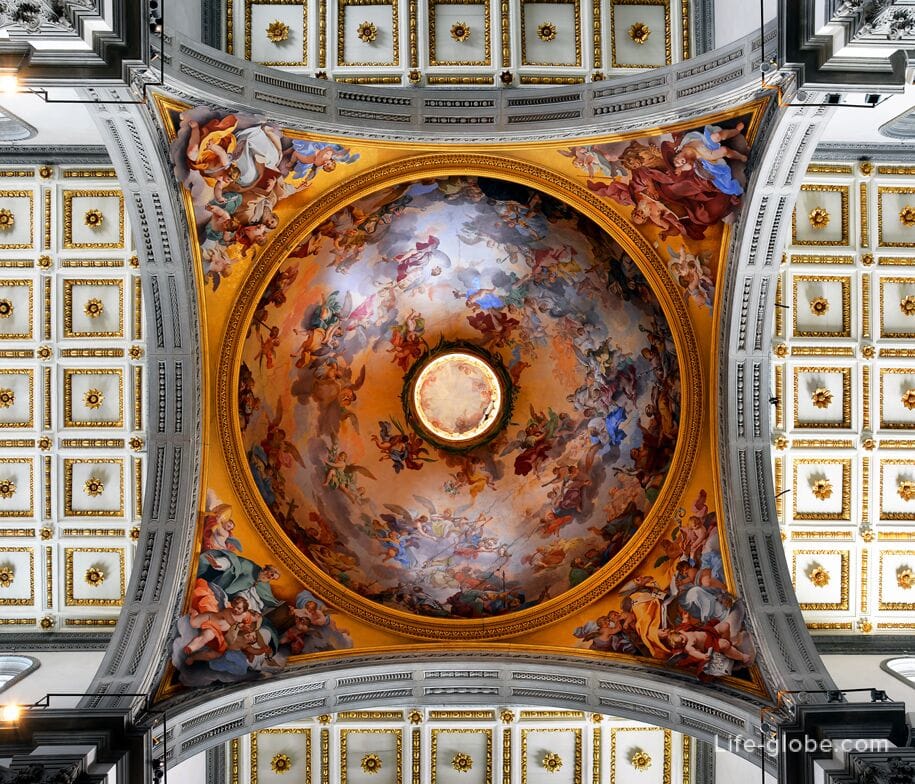
Two pulpits stand out in the interior, the bronze reliefs of which are outstanding works of art by the sculptor Donatello. The reliefs of the sarcophagi are dedicated to the history of the Passion of Christ and His Resurrection after the execution, so they are called "Pulpito della Passione" (Pulpito della Passione).
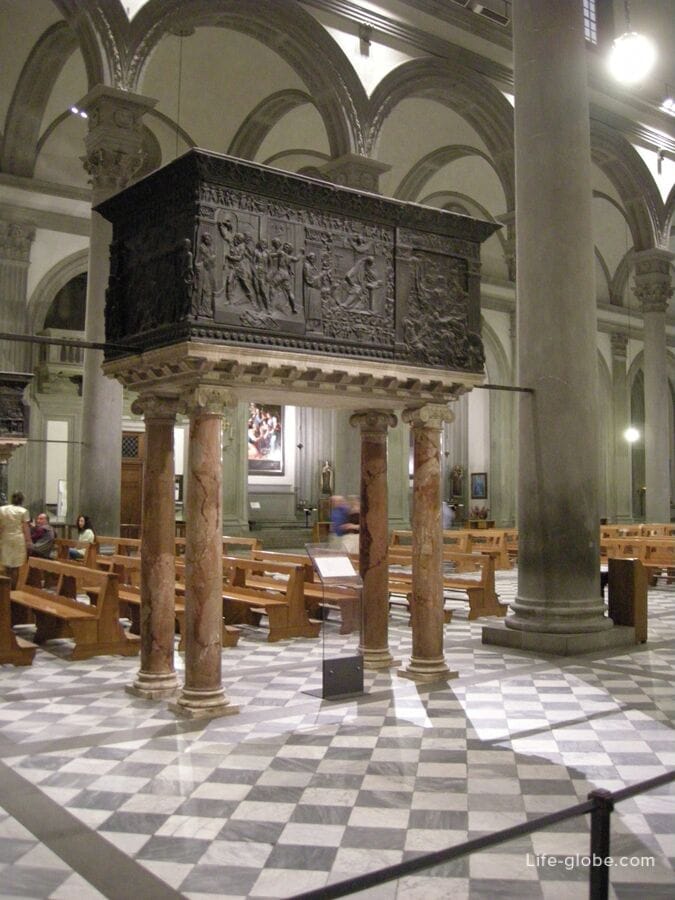
Old sacristy
Old Sacristy of San Lorenzo (Sagrestia Vecchia di San Lorenzo) is a square domed space that was paid for by the Medici and designed by Brunelleschi and is the oldest part of the current church and the only part completed during Brunelleschi's lifetime . Construction began in 1421 and was mostly completed in 1440.
The sacristy has an altar part; arched windows are placed in the lunettes above the entablature; The reliefs were made by Donatello. In the center is the sarcophagus of Giovanni di Bicci Medici and Piccard Bueri by Bugiano. Along one of the walls is a porphyry-bronze sarcophagus of Giovanni and Piero de' Medici by Verrocchio.

The name "Old Sacristy" began to be used after the construction of a "New Sacristy" commissioned by Giulio de' Medici (the future Pope Clement VII) was started on the other side of the transept of San Lorenzo in 1520 Michelangelo Buonarroti.
Here are the famous allegorical sculptures by Michelangelo: "Day", "Night", "Morning" and "Evening". "Day" and "Night" are located on the sarcophagus of Giuliano, Duke of Nemours - the youngest son of Lorenzo de' Medici, and "Morning" and "Evening" - on the sarcophagus of Lorenzo, Duke of Urbino (grandson of Lorenzo de' Medici, father of the French Queen Catherine de' Medici). Lorenzo the Magnificent himself and his brother Giuliano, who died during the Pazzi conspiracy, are also buried in the chapel. On a separate wall of the chapel: statues of the Madonna and Child and the patrons of the Medici family - Saints Cosmas and Damian.
The new sacristy is part of the Medici Chapel complex.

Treasury and Dungeons
In the basement of the basilica, which was once the residence of the Company of the Holy Communion (Compagnia del Santissimo Sacramento), there is now a museum of the treasures of San Lorenzo, where objects that for centuries formed the liturgical setting and precious reliquaries of the basilica are displayed.
In addition, there is an exhibition of five tables with drawings by Jacopo da Pontormo.
Also in the basement of the basilica you can see the graves of Giovanni di Bicci Medici, the monumental tomb-sarcophagus of Cosimo de' Medici the Elder and a tombstone in honor of Donatello.
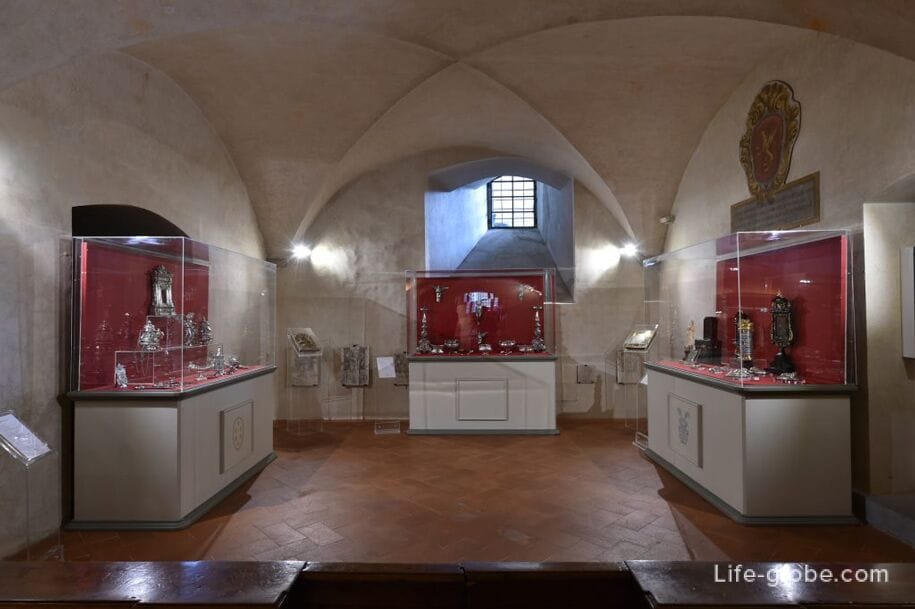
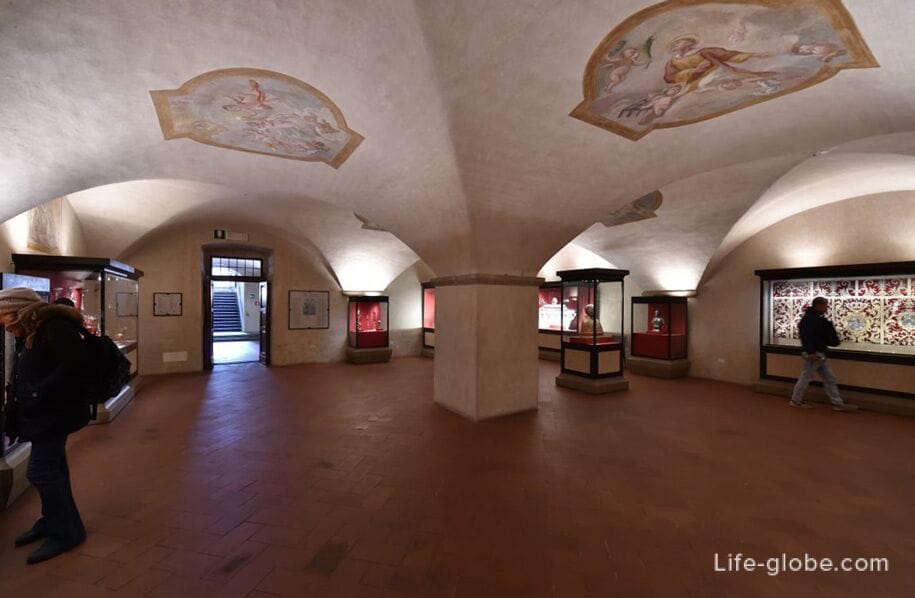
Monasteries
There were monasteries attached to the basilica.
The main monastery of the basilica got its name from the canons of San Lorenzo, who, since the foundation of the church, were entrusted with providing daily liturgy and care for souls.
Its current appearance is due to Antonio Manetti, a pupil and successor of Brunelleschi, who reconstructed it between 1457 and 1462, probably based on a previous project by Michelozzo, a trusted architect of Cosimo il Vecchio.
Large and harmonious, the monastery consists of two floors, concentrated around the courtyard and supported by elegant Ionic columns: the lower loggia, higher and airy, has round arches, and the upper one has an architrave.
There were once houses of canons and abbots around, as well as rooms intended for public life, such as the kitchen, refectory and chapter hall.
The second, smaller monastery, dating probably to the end of the fourteenth century, is the oldest part of the monumental complex, the only one that has preserved the features of the building before Brunelleschi.
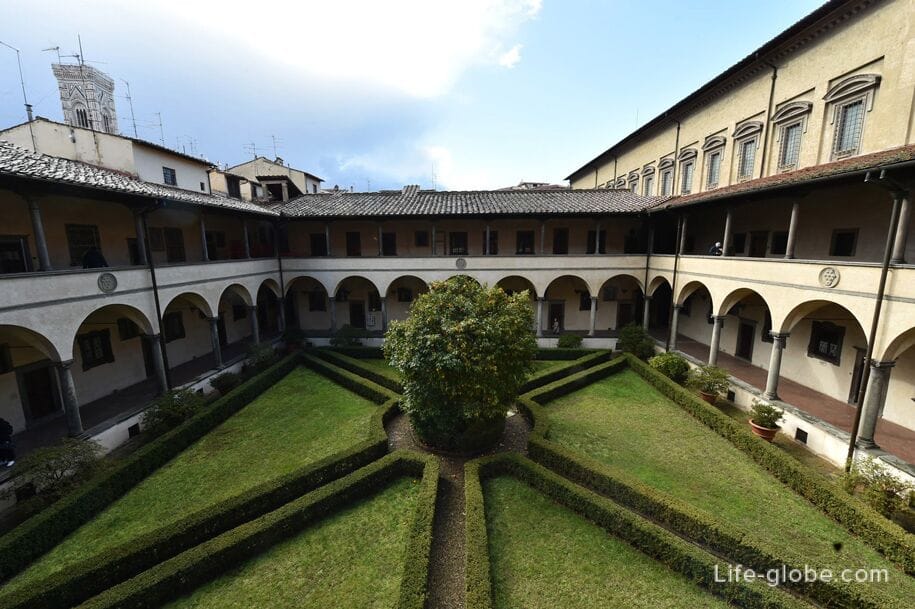
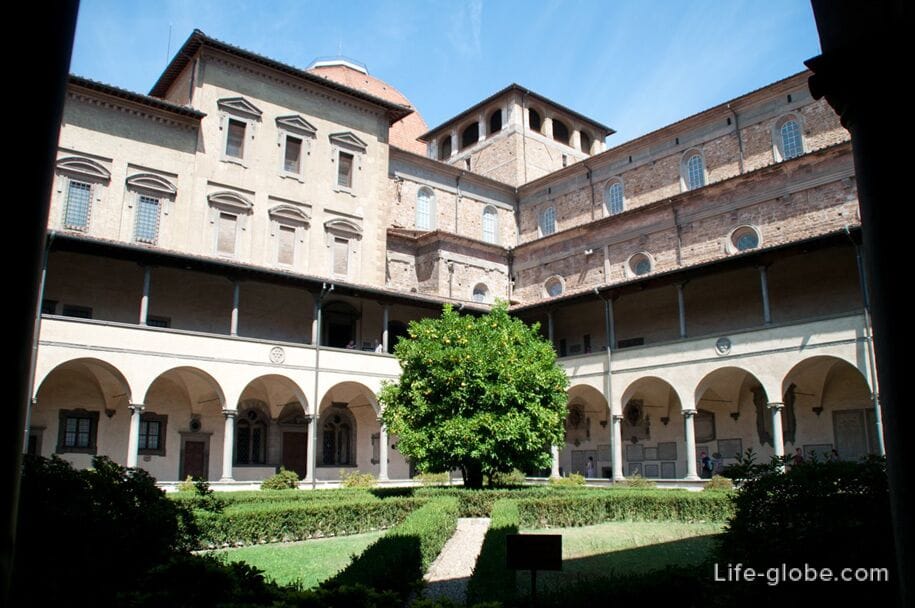
Medici Chapels
The Medici Chapel complex includes the Mausoleum of the Princes and a new sacristy by Michelangelo, conceived as a funeral chapel of the Medici family.
The two main parts are a continuation of the apse of the basilica (you can get into the chapels from the apse) and were built by Michelangelo, starting in 1519. The final design in 1603-1604 was designed by Bernardo Buontalenti based on models by Alessandro Pieroni and Matteo Nigetti.
The most famous and majestic part of San Lorenzo is the Medici Medici Chapel (Cappelle Medicee). Almost fifty younger members of the Medici family are buried here, up to the last member - Anna Maria Luisa Medici, who died in 1743. In 1742, she commissioned Vincenzo Meucci to paint the fresco "Glory of the Florentine Saints" inside the dome of the chapel.
Above is the Chapel of the Princes (Cappella dei Principi), where the Grand Dukes of Tuscany and their families are buried.
The chapel is completely covered with marble and semi-precious stones. The construction in 1604 was commissioned by Duke Ferdinando I to architect Matteo Nijetti. Bernardo Buontalenti participated in the development of the project.
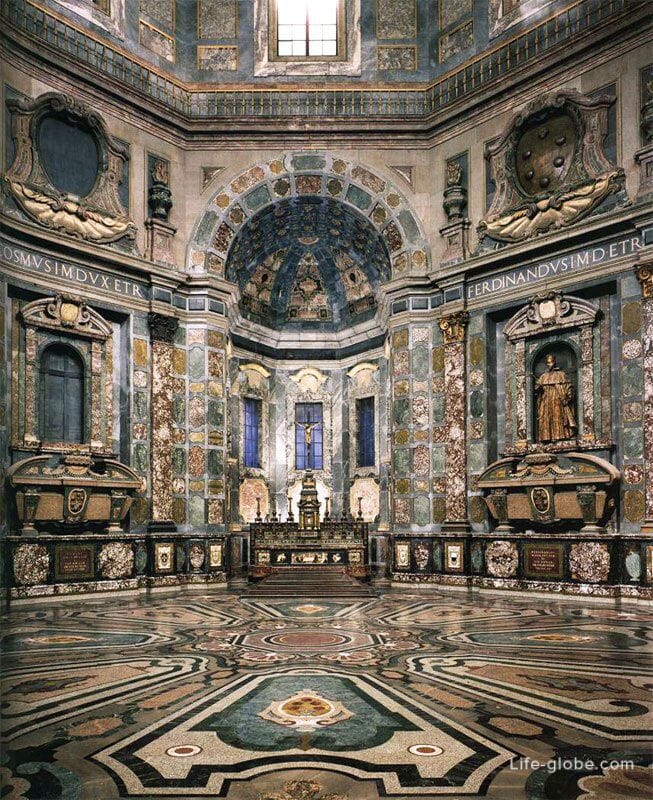
The Medici Chapels have been a state museum since 1869.
The museum consists of a New sacristy, the Chapel of the Princes, the Medici Chapel, and the Lorraine crypt, which contains, in addition to the remains of the Lorraine family, the tombstone of Cosimo, the old "Pater Patriae".
Laurenzian Library of San Lorenzo
By order of Pope Clement VII of the Medici, the Laurentian Library or Laurentian Library, also known as the Medici Library of San Lorenzo (La Biblioteca Medicea), was built to house the precious collection of the family's manuscripts designed by Michelangelo.
Michelangelo personally supervised the work between 1523 and 1534, the year of his move to Rome. The library was completed in 1571 by Giorgio Vasari and Bartolomeo Ammannati, commissioned by Cosimo I de' Medici to continue the work designed by Michelangelo and was opened to the public in the same year.
The access area, known as the lobby, is dominated by a large stone staircase built by Ammannati in 1559, modeled after Michelangelo.
The library has a reading room; exhibitions and events are held.
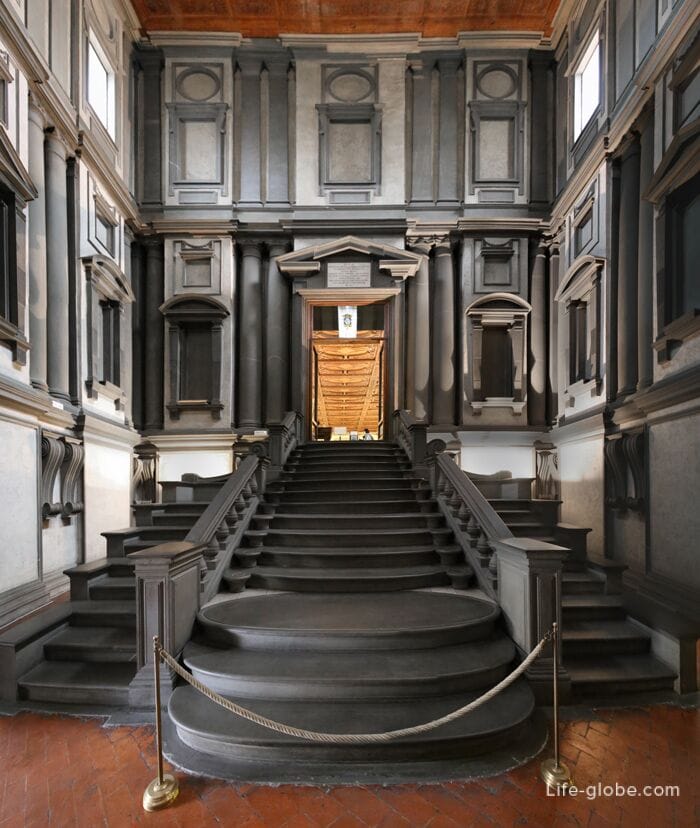
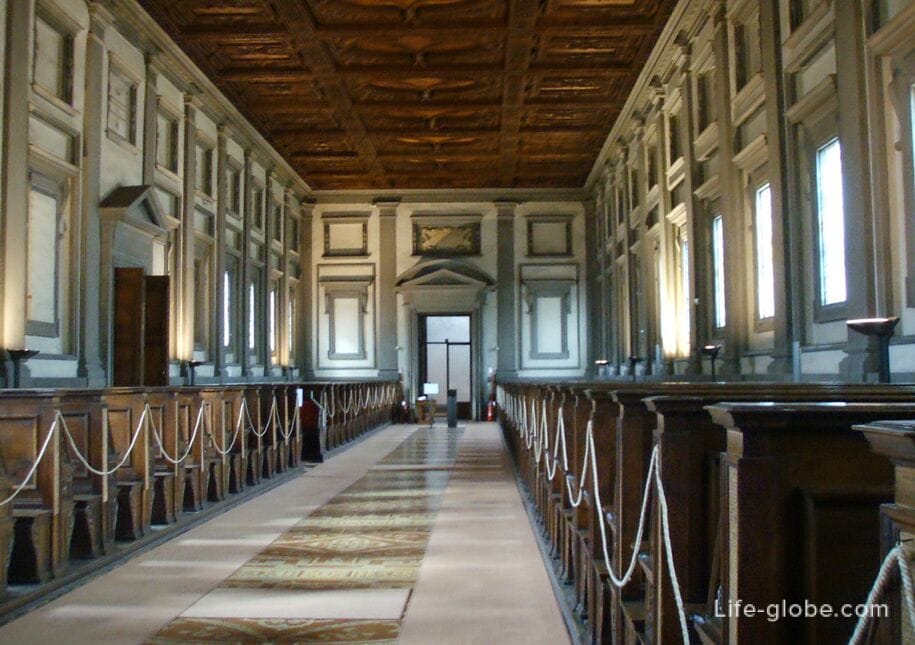
The Laurentian Library holds about 11,000 manuscripts, 2,500 papyri, 43 ostraca, 566 incunabula, 1,681 engravings of the 16th century and 126,527 engravings of the 17th and 20th centuries. The main collection consists of approximately 3,000 manuscripts indexed by Giovanni Rondinelli and Baccio Valori in 1589, which were placed on the parapets (plutei) at the opening of the library in 1571. These manuscripts include the Medici library, collected in the 15th century, which was re-acquired by Giovanni di Medici (Pope Leo X) in 1508 and transported to Florence in the 1520s by Giulio di Giuliano Medici (Pope Clement VII).
The library houses the Florentine Nahuatl Codex, the main source of Aztec life before the conquest. Other well-known manuscripts in the Laurentian Library include the Syriac Gospels of Rabul of the sixth century; the Amiatin Codex, which contains the earliest surviving manuscripts of the Bible in Latin Vulgate; the Codex Squarcialupi, an important early musical manuscript; the fragmentary papyrus of Erinna, containing poems by Sappho's girlfriend.
Photo of the Florentine CodexScheme of the San Lorenzo complex in Florence
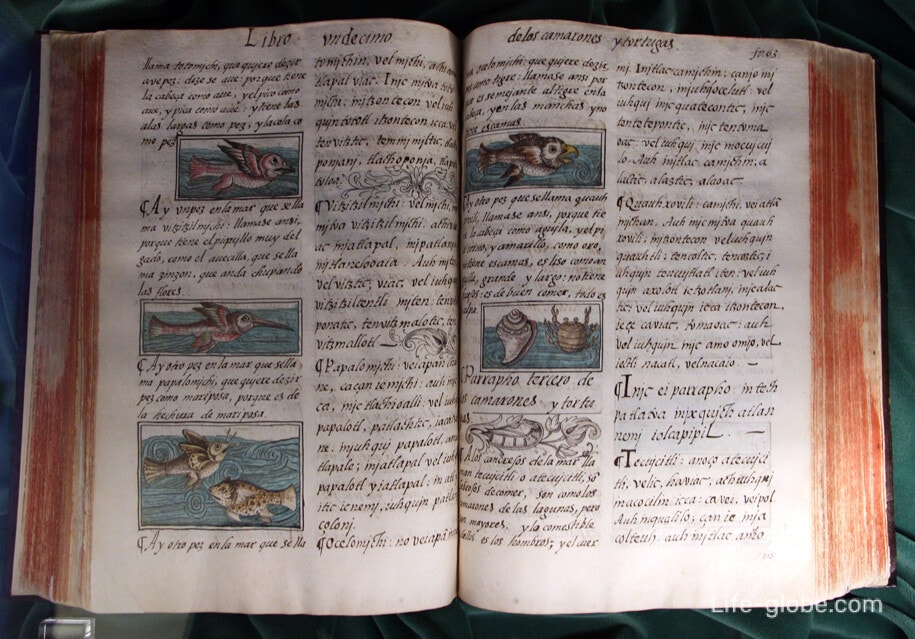
Scheme of the complex of San Lorenzo in Florence
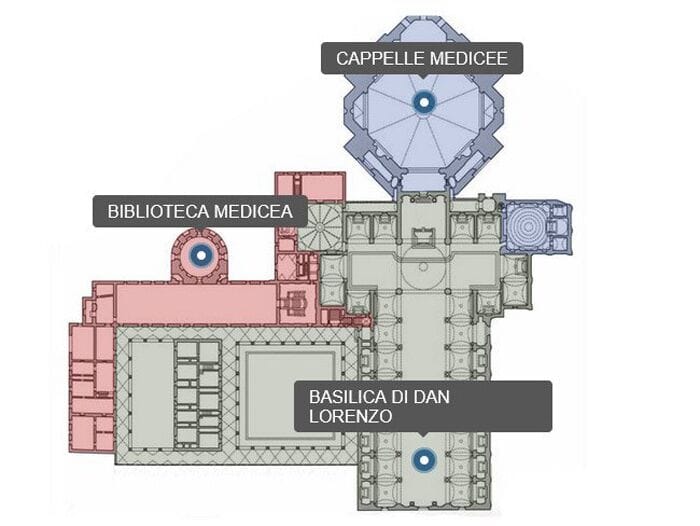
Practical information
Entrance to each of the three parts of the San Lorenzo complex is paid. There are discounted tickets and free entrances.
Information about the cost of tickets, opening hours, conditions of visits, etc., we recommend checking on the official websites.
1. Basilica of San Lorenzo, old sacristy, monasteries, museum, crypt and monumental dungeon, website: sanlorenzofirenze.it. Tickets can be purchased at the San Lorenzo ticket office.
2. Library, website: bmlonline.it. Tickets can be purchased at the ticket office or online in advance on the website.
3. The Medici Chapels are part of the Bargello National Museum, which, in addition to the chapels, also includes: the Bargello Palace Museum, the Orsanmichele Church Museum, the Davanzati Palace Museum and the Martelli House Museum. You can buy a ticket only to the Medici Chapels or a comprehensive ticket to all the objects of the Bargello Museum. The complex ticket is valid for 72 hours. Tickets can be purchased at the museum's ticket office or online in advance on the website. Website: bargellomusei.beniculturali.it.
The address of the complex San Lorenzo: Piazza di San Lorenzo, 9, 50123 Firenze FI, Italy.
Coordinates of the San Lorenzo complex: 43°46'29.0"N 11°15'13.0"E (43.774722, 11.253611).
All accommodation facilities in Florence (hotels, apartments, guest houses, etc.), including in the historical center of the city and more remotely from it, can be viewed and booked here




